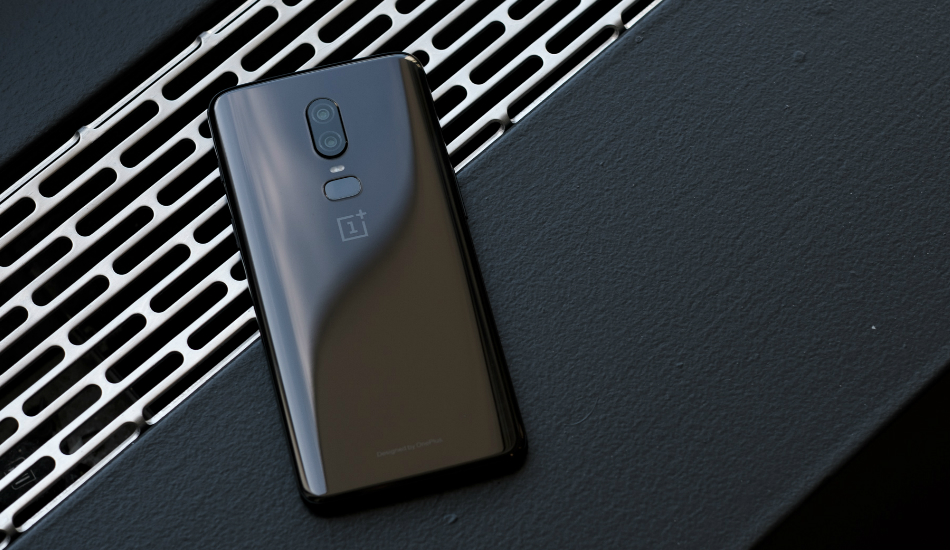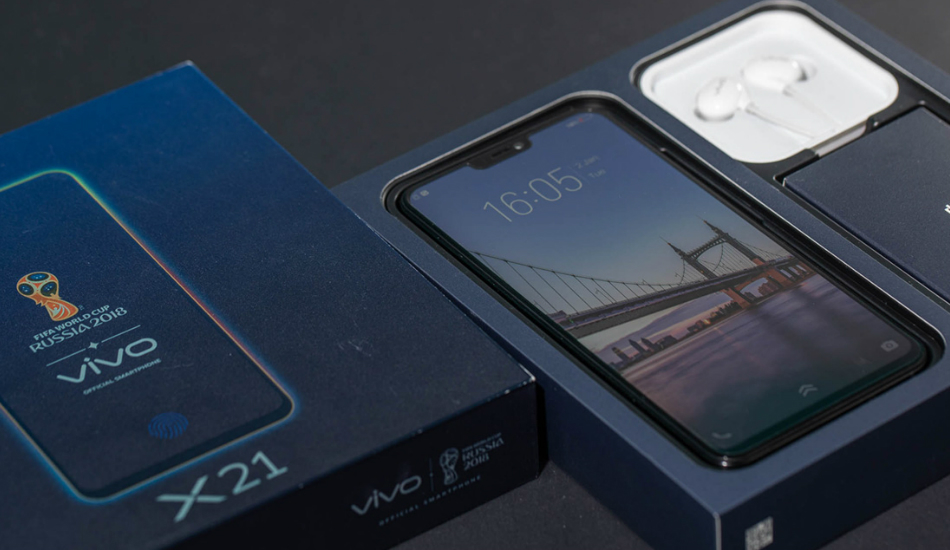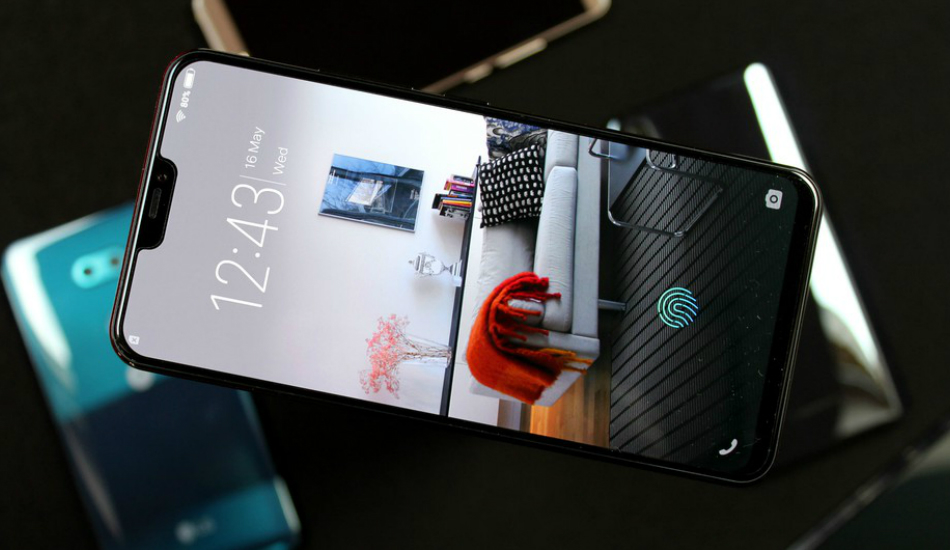Vivo just announced the Vivo X21 with an in-screen fingerprint scanner as a Flipkart exclusive in India. Coming in at an asking price of Rs 35,990, the Vivo X21 will line up as a direct alternative to the newly launched OnePlus 6 and Huawei’s Honor 10 which also made its release earlier this month. All three phones come at a sub Rs 36,000 price segment and bring high-end specifications and features that match the likes of the industry’s expensive offering from Samsung, Apple, and LG.
Let’s take a look at the three mid-level smartphones and see for ourselves whether a user needs to pay double this price for a high-end flagship.
Build & Design:
For the many things it offers as features, the Vivo X21 also doesn’t come short in terms of design. The phone offers a stronger build which weighs lesser than its OnePlus counterpart at 156 grams. There’s a glass screen on the front with the dreaded notch at the top which curves itself around the edges which are metallic. There is a glass finish at the rear end as well which gives the device a premium feel. The only shortcoming of the X21 comes due to the only Black coloured variant of the smartphone while its alternatives pack several more.

The OnePlus 6, unlike its predecessors, is made of an all-glass design made of Gorilla Glass 5 which is of the same form factor as on the Vivo smartphone. The OP6 offers its customers a little more variety in terms of choosing the variant that most pleases them. While the “Mirror Black” version offers a shiny and glossy finish that reflects back your face when looked at, the gorgeous “Midnight Black” model offers more of a classic matte finish that looks a lot like the Matte Black MacBook Pro that was launched a couple years ago. There’s also a Silk White version with gold accents, all of which will be inscribed with “Designed by OnePlus” at the back.
.jpeg)
Probably the best-looking smartphone of the three is the Honor 10 which Huawei claims to have been made with 15 layers of 3D glass at the back which gives the device a colourful radiance on every angle it’s looked at. While some might call the multi-shaded variants extremely flashy, the mere deviation from a standard looking phone makes the Honor 10 pleasant to the eye. The phone comes in Phantom Green, Phantom Blue as well as Midnight Black and Glacier Grey options that are equally reflective and elegant looking.
Winner: Huawei Honor 10
Display:
While all three displays come with an elongated aspect ratio of 19:9 and a Resolution of 1080 x 2280 pixels, the mere fact that the Honor 10 has a smaller 5.84-inch screen, makes it more dense and sharp to look at. Thus the Pixel density on the Huawei device is the highest of the three with 432 ppi. However, the Honor 10 has the largest bezels of the three phones with a thick bottom chin that minimizes the screen-to-body ratio of the phone to 79.9 percent.

The OnePlus 6 and Vivo X21 offer a larger 5.84-inch display with the same resolution as that of the Honor 10. But the Vivo flagship amounts to as much as 85.2 percent screen-to-body ratio, the highest of the three, followed by the OnePlus 6 at 83.8 percent.
Winner: Vivo X21
Hardware:
The specifications front is where all three devices can be distinguished to the core. The OnePlus 6 is powered by the latest industry’s top-of-the-line octa-core Snapdragon 845 Chipset clocked at 2.8GHz with 6GB of RAM and 64GB of onboard storage which is enough for a phone to be used as a daily driver.
The Honor 10 also loads up a high-end system-on-chip but it comes with Huawei’s own Hisilicon Kirin 970 chipset which matches the SND 845 on paper. The device comes with 6GB of RAM and 128GB of internal storage sufficing all needs with no lag whatsoever. The Honor 10 and OP6 not only employ flagship chipsets inside but also come with USB Type-C connectivity which has become a norm for faster data and charging.
On the innards, the Vivo X21 takes a hit as it only opts for a mid-level Snapdragon 660 Processor but still offers 6GB of RAM and 128GB of storage. The phone runs pretty smooth on a day to day usage but we still doubt if it will live up to the high standards set by the Huawei and OnePlus flagships. Vivo also only packed the much older Micro USB port for charging, which shows how the company has effectively cut short on the prices.
Winner: OnePlus 6 and Honor 10
Biometrics:

While the Vivo X21 might have come short in terms of performance, the device, unlike any other current generation smartphones, comes with an in-screen fingerprint scanner for authentication purposes. Upon touching the screen, the OLED display on the X21 illuminates to activate the under display optical sensor which recognizes and captures the reflected light of a user’s fingerprint and processes it for verification.
The Honor 10, unlike any Android device, comes with a biometric fingerprint scanner which is located below the display on the bottom chin but is placed in such a way that it sits under the same glass as its display. The fingerprint provides no haptic feedback, nor can it be clicked like a button but the placement of the sensor makes it protected from random scratches as well as bumps. There’s facial unlocking as well which works most of the times though Huawei needs to make it even snappier.
OnePlus didn’t boast any breakthroughs in implementing its Biometrics system as the fingerprint scanner on the OP6 is conventionally located at the back of the device under its camera module. Though the sensor has been cut short in size to shape up in a rectangular form, it allows no room for lags and works without any worries. While not as precise as Face ID, the facial recognition system on the OnePlus 6 works like a charm and could well be the fastest Android device to pull it off.
Winner: Vivo X21
Software:
All three devices mentioned in this list come with the latest Android 8.1 Oreo which works differently on all three. With Honor 10 and Vivo X21 come the heavily customized EMUI 8.1 and Funtouch OS 4.0, both of which, although provide a ton of personalizations, also slow them down in the long run. Both interfaces are heavily inspired by Apple’s iOS though there’s a learning curve to keep in mind when buying these two devices.
The OnePlus 6 in this scenario offers a near-to-stock Android Oreo experience with regular updates as well as a clutter-free homescreen. The “pure” Android also does a great deal of smoothness to the device. Users can now replace the stock on-screen buttons for gesture navigation that works a lot like the one on the iPhone X. Although not as stable and smooth like on the Apple device, the gestures on the OP6 leave you with an immersive full-screen experience to cherish.
Winner: OnePlus 6
Camera:
OnePlus 6
While the OnePlus lineup was never on par with the flagship smartphone cameras, the OnePlus 6 has made a lasting impressing in terms of imaging, unlike its predecessors. For those who don’t know, the OP6 equips a dual camera setup with a 16MP lens that features optical image stabilization and f/1.7 Aperture alongside a secondary 20MP sensor with the same fixed aperture. Both Sensors are placed vertically adjacent to each other with a dual-LED flash below the camera module.
Specifications aside, the OP6 has the best camera setup among any OnePlus phone and is a solid performer with decent colour saturation, balance, sharp details and good dynamic range. The Portrait mode offers a ton of detail and asmoother transition from subject to the background, which is blurred with a satisfactorily good amount of depth of field. Users will be able to record 4K videos at 60 fps, 1080p videos at 240 FPS and slow-motion videos of 720p resolution at 480 fps.
Honor 10
The camera on the Honor 10 is its biggest selling point as it comes with a dual 16 MP (f/1.8) + 24 MP cameras that cater to the need of mobile photographers by auditing an extra layer of AI into the mix. The artificial intelligence-enabled dual camera will be able to recognize up to 500 plus scenarios across 22 categories. The camera which is integrated with the first of its kind Semantic Image Segmentation technology can precisely identify and pinpoint multiple objects in a single frame.
.jpeg)
This further allows the AI to bring out the best colours of these objects in a picture by applying scene and subject-specific parameters on every photo in real-time, giving the picture you click, a touch of class within a fraction of a second. Even the 24MP camera on the front is supported by AI 2.0 technology which recognizes a user’s face and detects facial points to bring out studio-like portrait photographs.
Vivo X21
Having become a standard in even budget smartphones, the dual camera on the Vivo X21 is made up of a 12MP dual Pixel PDAF sensor with f/1.8 aperture, 1/2.5″, 1.4µm pixel size alongside a 5MP lens with f/2.4 aperture, aligned vertically next to each other. While Vivo claims to offer 4K recording at 30 fps and slow-motion recording, the camera on the X21 is clearly not the USP of the phone.
Winner: Honor 10
Battery:
While the Vivo X21 provides Fast charging to its 3,200mAh battery, Vivo clearly doesn’t mention to what extent its flagship is capable of in terms of battery and quick charging.
The Honor 10 is a bit of a gamble as this is the first time Huawei is carrying a 5V/4.5A adapter (that amounts to 22.5 W) to charge up the 3,400mAh power unit on the phone. Huawei claims that the Honor 10 will charge from zero to 50 percent in under 24 minutes which is surprising since its faster than the Dash Charge that OnePlus provides.
That said, OnePlus 6 comes with a large 3,300mAh battery with its traditional Dash Charge technology which juices up the phone through a 5V 4A 20W charger. The device takes as less as 100 minutes to charge up from zero to 100 percent and might last up to two days on light usage. This is where OnePlus has right quoted “a day’s power in half an hour” as you can expect the phone to be charged to 50 percent in under a half an hour.
Winner: OnePlus 6, followed in closely by Honor 10.
Verdict:
The latest Vivo X21 is a breakthrough device for the Chinese manufacturer that boasts of a stylishly designed glass back with a crisp display that has minimal bezels. The X21’s USP is its in-screen fingerprint scanner and the mid-level specifications on the device don’t fail to impress either but with a price set at Rs 35,990, there are certainly other alternatives to look at.
The OnePlus 6 that comes in at a cheaper price tag of Rs 34,999, boasts of flagship specifications which don’t compromise on the design aspects either. The phone packs a well saturated narrow 6.28-inch display with several options to choose from including Midnight Black, Pearl White, and Mirror Black back panels. The OP6 offers the “purest” Stock Android experience among the three, has gesture controls like the iPhone X and comes with a responsive facial recognition system and is the whole package at the sub Rs 40k price mark.
The cheapest of the three is Huawei’s Honor 10 which neither compromises its performance with its Kirin 970 chipset nor does it come short of its competitors in terms of design. In fact, the Honor 10 is by far the best-looking smartphone even if we match it alongside flagships like the Pixel 2 and Galaxy S9. The phone distinguishes itself from the rest through its under-glass fingerprint sensor which is still not on the screen and offers an AI-enabled camera that turns any normal looking image into a breathtaking picture. Although the fingerprint sensor amounts to a bottom chin, the display is by far the densest and sharpest of the lot by still hanging on to a 19:9 aspect ratio. All this, for a steep low price of Rs 32,999, makes the Honor 10 a winner, if you can adjust to the heavily skinned EMUI 8.1 interface.

